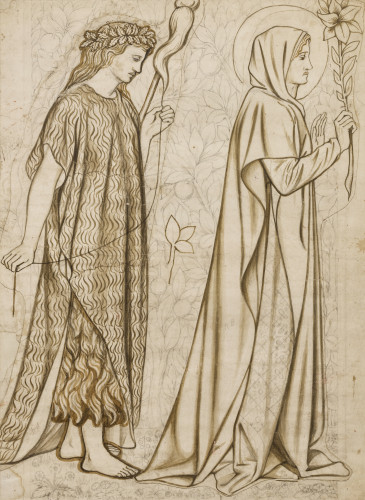This design is for part of a large stained glass window in the church of All Saints, Middleton Cheney, Northamptonshire. It shows Eve (the figure on the left) walking behind the Virgin Mary in a reference to the Christian doctrine that celebrates Mary as the redeemer of Eve’s sin in the Garden of Eden. The figures are set against rich foliage—typical of Morris’s talent for creating flat, decorative pattern, and small flowers are visible at their feet, perhaps inspired by Morris’s knowledge of millefleur motifs found in medieval tapestry. This design is a working drawing and is annotated with instructions, such as ‘R’ indicating the use of red glass for the inner layer of the Virgin’s robe.
Stained glass was one of William Morris’s first artistic pursuits and an important product in the early days of Morris, Marshall, Faulkner and Co., the interior decoration firm that Morris established in 1861. Morris leased premises at 8 Red Lion Square, London, and installed a kiln for firing glass and tiles in the basement. While Morris did not make the glass himself, preferring instead to order glass from more established companies such as James Powell & Sons, he breathed new life into the revival of historic stained glass techniques that was gathering pace in the nineteenth century. Key characteristics of Morris’s stained glass are an interest in simple forms reminiscent of medieval examples, the use of earthy, jewel-like colours, and the placement of pieces of coloured, ‘pot glass’ within a lead framework, creating patterns and images through a mosaic technique, as well as painting directly on to plain glass.
The cartoon was first designed by Morris for the chancel East window church of All Saints, Middleton Cheney, Northamptonshire, erected in 1865. The cartoon of Eve and the Virgin was used only once again, at Greenock, Renfrewshire, Scotland, in the North Church (Old West Kirk) in 1865 for the window in the west gable. The window has 4 lights and tracery, with 3 tiers of subjects, Eve and the Virgin being used for a panel in the bottom tier at left. The window also used the cartoons of the Angel with cymbals and Angel with lunette dulcimer designed by Burne-Jones and originally used at Lyndhurst in Hampshire. The church was demolished in 1926 to make room for shipyard extensions, the glass being re-fitted in the new church in Campbell Street.

